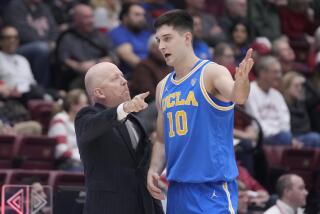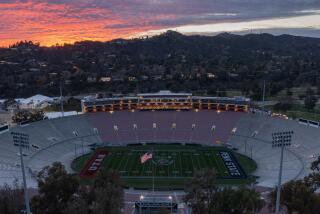DRAWING BLANKS
This must be about money, right? When UCLA Athletic Director Peter Dalis bemoans declining attendance at Pauley Pavilion, isn’t that a nice way of saying that the Bruins aren’t making as much money on ticket sales as they used to?
That is the logical conclusion, perhaps, but the wrong one. Thanks to the highest prices in the Pacific 10 Conference, the Bruins have weathered several seasons of declining attendance without suffering a significant loss of revenue.
“Financially, we’re doing fine,” Dalis said.
The Bruins’ average ticket price is $26.66, a Times survey found, 19% higher than the next highest average in the Pac-10. The top four schools in the conference standings charge the most, with the average price more than $20 at California ($22.45), Stanford ($21.76) and Arizona ($20.68).
A family of four, according to the Fan Cost Index established by Chicago’s Team Marketing Report, pays $157.64 to attend a UCLA game, assuming the purchase of four average-price tickets, parking, two programs, four hot dogs, four sodas and two souvenir caps. The Bruins also lead the league in that category, followed by Cal ($156.80), Arizona ($151.72) and Stanford ($147.02).
USC ranks sixth in average ticket price ($16.00) and fifth in cost for a family of four ($127.00).
Although individual game tickets can cost two or three times more than a movie ticket--four times, if you have a $41 ticket to the UCLA-Stanford game--Pac-10 Commissioner Tom Hansen said he did not consider basketball prices overly high. A theater can show a movie over and over, he said, while the costs to stage a live sporting event can be recouped only once.
“I don’t think a movie can compare,” he said.
In terms of price, Pac-10 tickets are a bargain compared to the NBA. The average price for a Laker ticket is $87.69, and for a Clipper ticket it is $44.81, according to Team Marketing Report, with the cost for a family of four at $446.74 for a Laker game and $265.73 for a Clipper game.
The Bruins’ falling attendance wrapped itself into part of a larger issue in January, when Dalis acknowledged speaking twice to former Boston Celtic coach Rick Pitino. In one conversation, Pitino recalled Dalis saying, “I’m not sure what’s happening. Our attendance is really down.”
The Bruins’ season-ticket count of 10,598 is the lowest in six years and has declined for the third consecutive year. The average attendance of 8,217 is the lowest in eight years and has declined for the fourth consecutive year.
However, increases in the cost of the conference’s most expensive tickets have allowed the Bruins to boost ticket revenue from $2.7 million in 1992-93 to $4.5 million in each of the past two seasons. The Bruins lost more than 500 season-ticket holders from 1998-99 to last year but lost only $329 in ticket revenue. (The Bruins lost more than 900 season-ticket holders this year and could face a slight decrease in ticket revenue by year’s end.)
So, if money isn’t the issue for Dalis, what is?
“It’s just the environment,” he said. “You want to have a full house at Pauley Pavilion.”
Put aside the dollar signs, and the troublesome number is this: 2,381, the difference between season tickets sold and average attendance, the highest during the five-year tenure of Coach Steve Lavin. That means, for the average UCLA game, more than 2,000 tickets are bought but not used. And that means television cameras showing empty seats in prime locations, because many season-ticket holders skip less attractive games and do not or cannot find others to use the tickets.
“In L.A., people tend to show up for games they want to show up for, and for other games they just don’t show up,” Dalis said.
The Bruins have drawn fewer than 7,000 fans to seven home games this season. They may sell out for Arizona and Stanford, but Pauley Pavilion is half-empty for the likes of UC Santa Barbara, Hawaii and Oregon State.
“You don’t see that at Cameron [Indoor Stadium at Duke]. You don’t see that at Chapel Hill [home of North Carolina],” said David Carter of the Sports Business Group in Redondo Beach.
Hansen declined to address the UCLA situation in particular but said blocks of empty seats at any conference school worry him.
“It becomes a concern, as a reflection of lack of interest,” Hansen said. “That is something you never want to have.”
Is there a lack of interest in opponents perceived as inferior? Perhaps, and why fight traffic to watch the Bruins play Washington when every UCLA home game is televised?
Is there a lack of interest in erratic play early in recent seasons, with the annual defections of underclassmen to the NBA draft forcing Lavin to reload each summer and rebuild each fall? Perhaps, and Lavin acknowledged this season’s upset loss to Cal State Northridge “might have had an effect.”
Is there a lack of interest in Pauley Pavilion? For the moment, perhaps, because Staples Center still is a novelty, the Lakers are defending NBA champions and the Clippers are supporting a young, exciting team with an unprecedented marketing blitz.
Is there a lack of interest in paying the highest ticket prices in the conference? Apparently not, because the most expensive tickets are almost always renewed, with donations of $750 to $5,000 required for the chance to purchase those tickets. The so-called cheap seats, located in the corners of the upper level and ranging from $17 to $35 per game depending on the opponent, are the ones the Bruins struggle to sell, for a game or a season.
The Bruins have won 20 games in each season under Lavin, advancing to the Sweet 16 of the NCAA tournament three times in his first four seasons. But, whatever the reason, the UCLA record--and the heritage of 11 national championships--isn’t selling itself.
“If they start to have a lot of empty seats, it starts to suggest this isn’t the hottest place in town. You can’t afford that in L.A.,” said Rick Burton, director of the Warsaw Sports Marketing School at the University of Oregon.
Could Pitino have restored that buzz to UCLA? Even if Dalis never offered Pitino a job, Burton said, he had to be thinking about it.
“I don’t mean to put Steve Lavin on the hot seat, but that’s one of the reasons you look at a Rick Pitino. You believe he will create a different energy,” Burton said. “From a distance, it looks like Steve Lavin has done everything you can ask of a college coach. Unfortunately, there’s a business of college sports that goes beyond winning.”
Dalis has described his conversations with Pitino as “innocent,” and Pitino has said Dalis “never specifically asked me about the UCLA job.” Dalis has since said that Lavin will return next season.
But, Carter said, Dalis was prudent in identifying attendance as an issue before the Bruins started to lose big money on ticket revenue and, perhaps, on merchandising, advertising and sponsorships.
“If you don’t tend to these things, what can happen is an erosion in brand recognition,” Carter said. “That’s what you’re seeing now, with the diminishing of the USC football brand name. That can hurt the financial integrity of the program.”
Lavin said Dalis has not said a word to him about attendance. The three priorities Dalis established for him, Lavin said, are winning, recruiting and graduating players.
“If we play at a high level, with a quality style of basketball, and we win a lot of games, we’re going to pack Pauley,” Lavin said. “If we play like we have in winning 15 of our past 17 games, attendance will never have to be a concern.”
(BEGIN TEXT OF INFOBOX / INFOGRAPHIC)
UCLA Attendance
Ticket sales are down, but increases in the highest ticket prices in the Pac-10 have allowed UCLA to weather the decline without taking a big financial hit:
*--*
Season Season Average Total Ticket Tickets Attendance(1) Revenue 1991-92 10,839 11,063 $2,887,540 1992-93 8,873 7,810 $2,725,991 1993-94 8,517 10,902 $2,913,906 1994-95 9,570 11,400 $3,167,518 1995-96 12,431 11,872 $3,448,417 1996-97 11,734 10,240 $4,082,523 1997-98 11,796 10,739 $4,159,869 1998-99 12,039 10,130 $4,450,779 1999-00 11,520 9,440 $4,450,450 2000-01 10,598 8,217(2) to be determined
*--*
(1) UCLA counts tickets used, not tickets sold.
(2) through last home game, Feb. 17; Source: UCLA *
Staff writer Sam Farmer contributed to this story.
More to Read
Go beyond the scoreboard
Get the latest on L.A.'s teams in the daily Sports Report newsletter.
You may occasionally receive promotional content from the Los Angeles Times.







